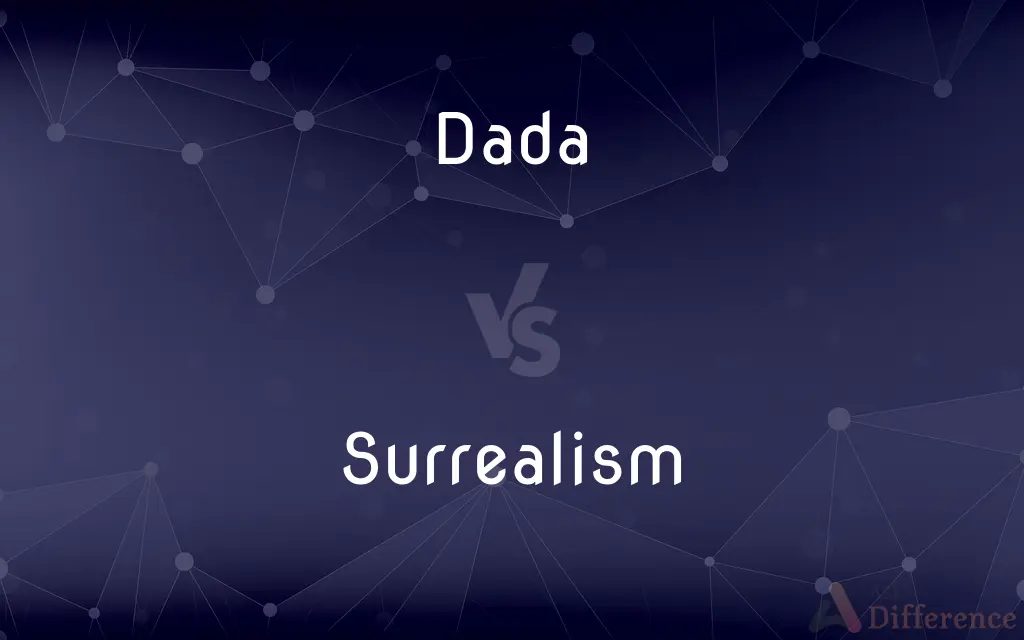Dada vs. Surrealism — What's the Difference?
By Tayyaba Rehman — Updated on September 21, 2023
Dada and Surrealism are both avant-garde art movements, with Dada emphasizing irrationality and anarchy as a protest against World War I, while Surrealism focuses on the unconscious mind, dreams, and the bizarre.

Difference Between Dada and Surrealism
Table of Contents
ADVERTISEMENT
Key Differences
Dada and Surrealism are integral parts of 20th-century art history, with both challenging traditional aesthetic values and societal norms. Dada emerged during World War I, rooted in negativity, chaos, and the rejection of logic. Artists in the Dada movement believed that the war was a result of the societal values of the time. Hence, Dada art was often nonsensical, provocative, and confrontational, deliberately aiming to shock and disturb.
Surrealism, on the other hand, had a more structured philosophy, evolving from the aftermath of Dada. It sought to bridge the gap between reality and dreams, emphasizing the role of the subconscious mind. Surrealism drew heavily from psychoanalysis, particularly the works of Sigmund Freud. The art often presented dreamlike landscapes and bizarre juxtapositions, providing viewers with a window into the artist's mind.
While Dada was a reaction to the horrors of war, challenging established norms with its chaos, Surrealism explored the depths of the human psyche. It aimed to liberate imagination and creativity from the confines of logic and reason. Both movements, however, played essential roles in shaping the trajectory of modern art.
Dada and Surrealism, despite their differences, are interconnected. Many artists who were initially involved in the Dada movement transitioned to Surrealism, seeing it as an evolution of their ideas. Both movements have left an indelible mark on art, literature, film, and even pop culture, showcasing the endless possibilities of human creativity.
Comparison Chart
Origin
World War I
Post World War I, from Dada
ADVERTISEMENT
Philosophy
Rejection of logic and societal norms
Exploration of the unconscious and dreams
Influence
Anti-art, anarchy
Psychoanalysis, notably Freud
Key Characteristics
Nonsensical, provocative
Dreamlike, bizarre juxtapositions
Purpose
Protest against the war and traditional values
Delve into the subconscious, bridge reality and dreams
Compare with Definitions
Dada
Characterized by unexpected juxtapositions and non sequitur.
A hallmark of Surrealism is the combination of unrelated objects in a single composition.
Surrealism
Was Dada a protest movement?
Yes, Dada protested against the societal values that led to World War I and traditional artistic values.
Dada
Heavily influenced by psychoanalysis.
Surrealism took inspiration from Freud's explorations of the unconscious mind.
Surrealism
Are there any famous artists associated with both movements?
Yes, artists like Salvador Dalí and Man Ray were associated with both Dada and Surrealism.
Dada
An art movement exploring dreams, the subconscious, and the bizarre.
Surrealism paintings often depict illogical scenes with precise, photo-like realism.
Surrealism
Did Surrealism only influence art?
No, Surrealism also had a profound impact on literature, film, and other forms of expression.
Dada
Aimed to bridge reality and the dream world.
Surrealism art offers viewers a glimpse into the artist's imagination.
Surrealism
Did Dada come before Surrealism?
Yes, Dada emerged during World War I, and Surrealism evolved from it post-war.
Dada
Dada () or Dadaism was an art movement of the European avant-garde in the early 20th century, with early centres in Zürich, Switzerland, at the Cabaret Voltaire (c. 1916).
Surrealism
What's the main focus of Surrealism?
Surrealism focuses on dreams, the unconscious mind, and the bizarre.
Dada
A European artistic and literary movement (1916-1923) that flouted conventional aesthetic and cultural values by producing works marked by nonsense, travesty, and incongruity.
Surrealism
Surrealism was a cultural movement which developed in Europe in the aftermath of World War I and was largely influenced by Dada. The movement is best known for its visual artworks and writings and the juxtaposition of distant realities to activate the unconscious mind through the imagery.
Dada
(childish) Father, dad.
Surrealism
A literary and artistic movement of the 1900s that attempts to express the workings of the subconscious and is characterized by fantastic imagery and incongruous juxtaposition of subject matter.
Dada
Heroin
Surrealism
Literature or art produced in this style.
Dada
An informal term for a father; probably derived from baby talk
Surrealism
An artistic movement and an aesthetic philosophy that aims for the liberation of the mind by emphasizing the critical and imaginative powers of the subconscious.
Dada
A nihilistic art movement (especially in painting) that flourished in Europe early in the 20th century; based on irrationality and negation of the accepted laws of beauty
Surrealism
A 20th century movement of artists and writers (developing out of Dadaism) who used fantastic images and incongruous juxtapositions in order to represent unconscious thoughts and dreams
Dada
Evolved from the Dada movement.
Many Dada artists, seeing potential in its ideas, moved towards Surrealism.
Common Curiosities
What's the main focus of Surrealism?
Surrealism focuses on dreams, the unconscious mind, and the bizarre.
Was Dada a protest movement?
Yes, Dada protested against the societal values that led to World War I and traditional artistic values.
Are there any famous artists associated with both movements?
Yes, artists like Salvador Dalí and Man Ray were associated with both Dada and Surrealism.
Did Surrealism only influence art?
No, Surrealism also had a profound impact on literature, film, and other forms of expression.
Did Dada come before Surrealism?
Yes, Dada emerged during World War I, and Surrealism evolved from it post-war.
Share Your Discovery

Previous Comparison
Monoclinic vs. Orthorhombic
Next Comparison
Newscaster vs. BroadcasterAuthor Spotlight
Written by
Tayyaba RehmanTayyaba Rehman is a distinguished writer, currently serving as a primary contributor to askdifference.com. As a researcher in semantics and etymology, Tayyaba's passion for the complexity of languages and their distinctions has found a perfect home on the platform. Tayyaba delves into the intricacies of language, distinguishing between commonly confused words and phrases, thereby providing clarity for readers worldwide.
















































